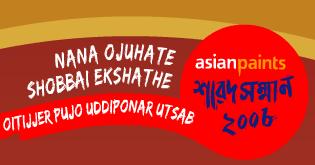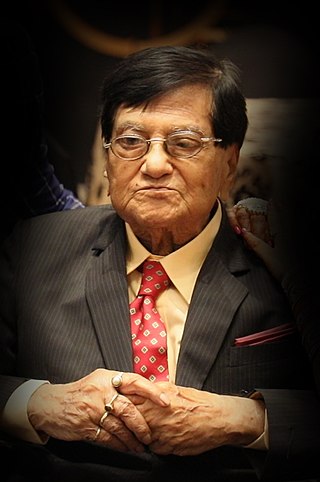
West Bengal is a state in the eastern portion of India. It is situated along the Bay of Bengal, along with a population of over 91 million inhabitants within an area of 88,752 km2 (34,267 sq mi) as of 2011. The population estimate as of 2023 is 102,552,787. West Bengal is the fourth-most populous and thirteenth-largest state by area in India, as well as the eighth-most populous country subdivision of the world. As a part of the Bengal region of the Indian subcontinent, it borders Bangladesh in the east, and Nepal and Bhutan in the north. It also borders the Indian states of Jharkhand, Odisha, Bihar, Sikkim and Assam. The state capital is Kolkata, the third-largest metropolis, and seventh largest city by population in India. West Bengal includes the Darjeeling Himalayan hill region, the Ganges delta, the Rarh region, the coastal Sundarbans and the Bay of Bengal. The state's main ethnic group are the Bengalis, with the Bengali Hindus forming the demographic majority.

Durga Puja, also known as Durgotsava or Shaaradotsava, is an annual festival originating in the Indian subcontinent which reveres and pays homage to the Hindu goddess Durga, and is also celebrated because of Durga's victory over Mahishasura. It is particularly celebrated in the Eastern Indian states of West Bengal,Tripura, Bihar, Jharkhand, eastern Uttar Pradesh, Assam, Odisha and by Hindus in Bangladesh. The festival is observed in the Indian calendar in the month of Ashvin, which corresponds to September–October in the Gregorian calendar. Durga Puja is a ten-day festival, of which the last five are of the most significance. The puja is performed in homes and public, the latter featuring a temporary stage and structural decorations. The festival is also marked by scripture recitations, performance arts, revelry, gift-giving, family visits, feasting, and public processions called a melā. Durga Puja is an important festival in the Shaktism tradition of Hinduism. Durga Puja in Kolkata has been inscribed on the intangible cultural heritage list of UNESCO in December 2021.

Jagatdhatri or Jagaddhatri is an aspect of the Hindu goddess Durga, worshipped in the Indian state of West Bengal and other states like Odisha and Jharkhand. Jagaddhatri Puja is particularly famous in Chandannagar town of Hooghly district,Krishnanagar of Nadia district and Ichhapur Nawabgunj of North 24 Parganas in West Bengal where it is celebrated as a five-day-long festival. Her worship and rituals are derived from Tantra. It is believed that her worship frees her devotees from ego and all other materialistic desires.

Mamata Banerjee is an Indian politician who is serving as the eighth and current chief minister of the Indian state of West Bengal since 20 May 2011, the first woman to hold the office. Having served multiple times as a Union Cabinet Minister, Mamata Banerjee became the Chief Minister of West Bengal for the first time in 2011. She founded the All India Trinamool Congress in 1998 after separating from the Indian National Congress, and became its second chairperson later in 2001. She is often referred to as Didi.

Krishnanagar is a city and a municipality in the Indian state of West Bengal. It is the headquarters of the Nadia district.
Kolkata has many festivals throughout the year. The largest and most magnificently celebrated festival of the city is Durga Puja, and it features colourful pandals, decorative idols of Hindu goddess Durga and her family, lighting decorations and fireworks. Other major festivals are Diwali, Kali Puja, Holi, Saraswati Puja, Poush Parbon, Poila Boishakh, Christmas, Eid al-Fitr, Eid al-Adha, etc.

The culture of West Bengal is an Indian culture which has its roots in Bengali literature, music, fine arts, drama and cinema. Different geographic regions of West Bengal have subtle as well as more pronounced variations between each other, with Darjeeling Himalayan hill region and Duars showing particularly different socio-cultural aspects.

Guptipara is a census town in Balagarh, a community development block that forms an administrative division in the Sadar subdivision of the Hooghly district in the Indian state of West Bengal.
Barowari refers to the public organisation of a religious entity, mainly in West Bengal, India. Barowari has significance associated with the Durga Puja festival, in which the Hindu Goddess Durga is worshipped; symbolising the victory of good over evil. The word "Barowari" comes from the Sanskrit words "bar", which means public, and Persian word "wari", means For.

The dhak is a huge membranophone instrument from Bengal and Assam. The shapes differ from the almost cylindrical to the barrel. The manner of stretching the hide over the mouths and lacing also varies. It suspended from the neck, tied to the waist and kept on the lap or the ground, and usually played with wooden sticks. The left side is coated to give it a heavier sound.

Shobhabazar is a neighbourhood of North Kolkata, in Kolkata district, in the Indian state of West Bengal.

Asian Paints Sharad Shamman is an excellence award given to the best decorated Durga Puja Pandal in Kolkata during the festival in October. Since its inception in 1985, Asian Paints Sharad Shamman has been heralded as the true achievement for excellence in decorating the abodes for Goddess Durga. As time has progressed there have been numerous awards being given by many other companies for creative excellence, but still Asian Paints Sharad Shamman is considered the most important award and the rightful judgement for excellence. It is a trendsetter for all the later awards.

Navaratri is an annual Hindu festival observed in honor of the goddess Durga, an aspect of Adi Parashakti, the supreme goddess. It spans over nine nights, first in the month of Chaitra, and again in the month of Ashvin (September–October). It is observed for different reasons and celebrated differently in various parts of the Hindu Indian cultural sphere. Theoretically, there are four seasonal Navaratris. However, in practice, it is the post-monsoon autumn festival called Sharada Navaratri. There are 2 Gupta Navaratris or "Secret Navaratris" as well, one starting on the Shukla Paksha Pratipada of the Magha Month and another starting in the Shukla Paksha Pratipada of Ashadha Month.

Kali Puja, also known as Shyama Puja or Mahanisha Puja, is a festival originating from the Indian subcontinent, dedicated to the Hindu goddess Kali. It is celebrated on the new moon day of the Hindu calendar month of Ashwayuja or Kartika. The festival is especially popular in the region of West Bengal, and other places like Mithila, Jharkhand, Odisha, Assam, and Tripura, as well as the town of Titwala in Maharashtra, along with the neighbouring country of Bangladesh.

Lake Town is a neighbourhood in South Dumdum of North 24 Parganas district in the Indian state of West Bengal. It is a part of the area covered by Kolkata Metropolitan Development Authority (KMDA). One of the coveted neighbourhoods of the metropolis, it has a police station.

The Manicktala Chaltabagan Lohapatty Durga Puja is a Durga Puja celebration in Kolkata, India. It was founded in 1943 by Late Sri Lakhi Chand Jayaswal
Kurumgram is an old village located in Nalhati I CD Block in Rampurhat subdivision of Birbhum district in West Bengal State of India.

Metro Railway, Kolkata, is the owner and operator of Kolkata Metro, the oldest metro system of India. On 29 December 2010, it became the 17th zone of the Indian Railways, operated by the Ministry of Railways.
Tapati Guha-Thakurta is an Indian historian who has written about the cultural history and art of India. She is a director and professor in history at the Centre for Studies in Social Sciences, Calcutta, and was previously a professor at Presidency College, Kolkata. Her extensive research work on Kolkata's Durga Puja led to its inclusion in UNESCOs Intangible Cultural Heritage list.
Bullygune Cultural Association is the most famous Sarbojanin (public) Durga idol kept at Bullygunge, a prominent locality in south Kolkata in the state of West Bengal, during the Durga Puja festival. The idol is kept for public display for approximately 5 days Or more; thereafter it is immersed in the Ganges at Babu Ghat on the auspicious day of Vijayadashami.
![baagbaajaar saarbjniin durgo[?]sb 2018.jpg](http://upload.wikimedia.org/wikipedia/commons/thumb/e/e7/%E0%A6%AC%E0%A6%BE%E0%A6%97%E0%A6%AC%E0%A6%BE%E0%A6%9C%E0%A6%BE%E0%A6%B0_%E0%A6%B8%E0%A6%BE%E0%A6%B0%E0%A7%8D%E0%A6%AC%E0%A6%9C%E0%A6%A8%E0%A7%80%E0%A6%A8_%E0%A6%A6%E0%A7%81%E0%A6%B0%E0%A7%8D%E0%A6%97%E0%A7%8B%E0%A7%8E%E0%A6%B8%E0%A6%AC_%E0%A7%A8%E0%A7%A6%E0%A7%A7%E0%A7%AE.jpg/220px-%E0%A6%AC%E0%A6%BE%E0%A6%97%E0%A6%AC%E0%A6%BE%E0%A6%9C%E0%A6%BE%E0%A6%B0_%E0%A6%B8%E0%A6%BE%E0%A6%B0%E0%A7%8D%E0%A6%AC%E0%A6%9C%E0%A6%A8%E0%A7%80%E0%A6%A8_%E0%A6%A6%E0%A7%81%E0%A6%B0%E0%A7%8D%E0%A6%97%E0%A7%8B%E0%A7%8E%E0%A6%B8%E0%A6%AC_%E0%A7%A8%E0%A7%A6%E0%A7%A7%E0%A7%AE.jpg)






















